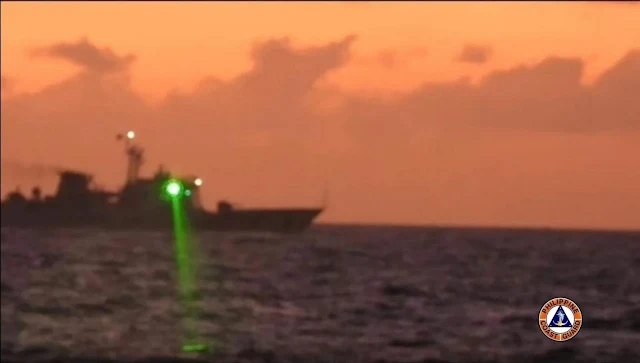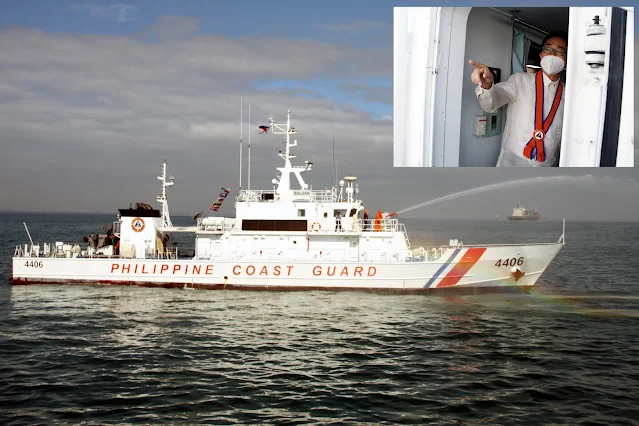The Philippine Coast Guard played a very essential role in ensuring presence in the West Philippine Sea, as this is the lawful way of enforcing its absolute right of patrolling the area surrounding the Kalayaan Island Group following the 2016 Arbitral Tribunal Ruling that provide the victory to the Philippines as it nullifies Chinese claims in the area.
Now, as tensions mounted and maritime patrols intensified, adding more white hulls for the Philippine Coast Guard to use are getting justified every single day.
INTRODUCTION - PCG'S INTEREST
%20-%20PDA.jpg) |
| Philippine Coast Guard's newest and largest flagship to-date. Via Wikimedia Commons. |
Earlier last January 2023, the Philippine Coast Guard expressed its desire to gain an additional five more 97-meter Multirole Response Vessels (Teresa Magbanua-class MRRVs) from Japan, as this intention has discussed by the PCG Commandant before his audience of the delegates representing JICA or Japan International Cooperation Agency, led by its President Dr. Tanaka Akihiko.
This is the latest in the series of modernization efforts surrounding the Philippine Coast Guard's fleet composition since the addition of the newly gained vessels like the said 97-meter Multirole Vessels that currently came with two (2) units, ten (10) 44-meter Parola-class vessels that also came from Japan as the Teresa Magbanua-class, and the BRP Gabriela Silang (OPV-8301) from France's OCEA.
The PCG Commandant continued his explanation that by having additional Teresa Magbanua-class Multirole Response Vessels in the Philippine Coast Guard, the maritime law enforcement agency may now have more vessels at its disposal that can conduct maritime domain awareness operations through constant patrol of the country's territorial and EEZ waters, rescue operations, and other functions that promotes the country's economic growth and development through maritime security.
Having additional Teresa Magbanua-class MRRVs in the Philippine Coast Guard, to take notes, may increase not only the presence of these ships in contested waters like the West Philippine Sea as it augments the smaller Parola-class MRRVs, but also has the capability of long endurance and loitering time in offshore waters which is ideal in countering ongoing Chinese Coast Guard aggression in the area.
In this topic, we will discuss the current incident that involves both the Chinese and Philippine Coast Guard vessels, the latter's desire to up-arming its existing white-hulled vessels, and pointing out further the capabilities of the Teresa Magbanua-class MRRVs, given with its design originating from Japan Coast Guard's Kunigami-class Offshore Patrol Vessels.
THE RECENT WEST PHILIPPINE SEA INCIDENT
 |
| China Coast Guard and its latest provocation as they laser BRP Malapascua (MRRV-4403) resulted in temporary blindness among Philippine Coast Guard personnel onboard. (c) Philippine Coast Guard, via Rappler. |
Chinese aggression is a current issue in the West Philippine Sea and the wider South China Sea area, as the series of events sparked by the provocations made by China Coast Guard and other Chinese actors in the area are getting recorded and in documentation that it is now in use as evidence for the international community to take notice, that such actions needs to be called out for being not in accordance to international norms.
Just recently, a China Coast Guard vessel near Ayungin Shoal in the West Philippine Sea aimed a military-grade laser on the Philippine Coast Guard personnel onboard BRP Malapascua (MRRV-4403), one out of ten Parola-class vessels newly gained by the agency from Japan alongside the likes of BRP Teresa Magbanua (MRRV-9701) and its sister ship BRP Melchora Aquino (MRRV-9702).
This comes as China continuously 'claims' Ayungin Shoal as "integral" and "inalienable" part of their territory as part of "Nansha islands", although this is clear from 2016 Hague Arbitral Decision that Chinese 'claims' over the entire wider South China Sea area or the West Philippine Sea, are clearly void, and it is just a legal right for the Philippine Coast Guard to conduct patrols in the area that it considers an integral part of the Philippines' sovereign right within its own 200 nautical mile Exclusive Economic Zone.
Take note that the Philippines currently has an outpost in Ayungin Shoal, which is the BRP Sierra Madre that was grounded there intentionally since 1999 and since then served as the country's primary outpost that shows its presence and determination that the shoal, like the rest of Kalayaan Island Group in the West Philippine Sea, are part of the country and has the right of exploiting maritime resources there as its sovereign right.
Currently, the Philippine Coast Guard is now increasing its presence in the West Philippine Sea, especially with the increasing presence of Filipino fishing vessels in the area coming alongside the upcoming season suitable for fishing, making sure that Filipino fishers in the area are safe from any provocation, especially the ones that targeted these vulnerable vessels coming from Chinese aggression in the area.
ARMING-UP
 |
| The Japanese Ambassador to the Philippines Kazuhiko Koshikawa points to the water cannon display by the Philippine Coast Guard during his visit at the PCG headquarters, Port Area in Manila, that took place on December 7, 2021. Image Source. |
It is not until recently that a recent incident involving a Chinese Coast Guard vessel aiming lasers and uncovering main gun turrets that the Philippine Coast Guard considered an idea of up-arming their vessels with guns, in a tit-for-tat attempt that may increase the chance of further provocation, as the former gets their gesture as an intimidation tactic, hoping they may scare other vessels in the area.
Let us take note that a nation's coast guard vessels with guns is not a new concept, as the United States Coast Guard cutters usually came with gun emplacements onboard. Even at one point, they even have a Harpoon antiship missile installed on one of their Hamilton-class cutters, whereby these ships has long since being out of service and now is in the hands of the navies of Bangladesh, Nigeria, Vietnam, Sri Lanka, and the Philippines, in which the Philippine one's being known as the Del Pilar-class Offshore Patrol Vessels.
In the Philippine Coast Guard's context, its primary mandate is clearly point out that the agency is primarily functioning as a maritime law enforcement agency in the pursuance of peace and order within the country's territorial and EEZ waters, as it is lining out from its mandate as an agency within the Department of Transportation, as opposed to the United States Coast Guard which, at the time this article has published, is a military branch under the Department of Defense.
That being said, it is just appropriate for the Philippine Coast Guard to keep their water cannons and have the option of adding lethal weapons like main cannons and machine guns opt out, as it is clear from its mandate that it is a civilian law enforcement agency, and that the option of getting military weaponry will be the job of the Philippine Navy since they are getting a bunch of Offshore Patrol Vessels for this type of operation.
COMPARING THE PAROLAS TO THE TERESA MAGBANUA MRRVS
 |
| Here are the specifications for both Multi-role Response Vessels or MRRVs of the Philippine Coast Guard. Sources are accessible to these links here: 1, 2, 3, 4. |
Based on the table presented above, the larger Teresa Magbanua-class Multirole Response Vessels (MRRVs) have a significant advantage that came with its size, as it has the better endurance or the cruising range and time spend for the vessels to loiter the West Philippine Sea for a longer time period, as compared to the 44-metered Parola-class Muti-Role Response Vessels like the BRP Malapascua (MRRV-4403).
Both the cruising and maximum speed between two multi-role response vessels of the Philippine Coast Guard are negligible to each other, as the 2,260 tonnage of the Teresa Magbanua-class MRRVs require a more powerful main engine, which is the 2x 6,600kW diesel engines it has onboard, comparing to the smaller and lesser-powered 2x 2,580kW diesel engines sufficiently enough for the 321-tonnage Parola-class MRRVs.
The larger dimensions that the Teresa Magbanua-class Multirole Response Vessels offer helps increase the prolonged presence of the Philippine Coast Guard in the West Philippine Sea, whereby the idea of adding more similarly sized vessels gives the agency increased capability to further implement its maritime domain awareness and security that the Philippine fisherfolk in the area needed as they faced harassment from China Coast Guard, along with ensuring deterrence from these white hulled threats from the area without the escalation that usual naval, gray-hulled vessels brought.
Also, the increased presence in the West Philippine Sea is a show of gesture and a message from the Philippines that it does not give up the features it consider as part of the country's Exclusive Economic Zone and continental shelf, particularly now that multiple countries ranging from the United States to others like Canada and Australia are showing support for the Philippine Coast Guard's legally patrolling the waters in the area others considered as "disputed".
Hence, the justifications provided suffice the support Philippine Coast Guard required in having additional vessels into its fleet, especially the ones equally sized to the current largest vessels it has coming from Japan, which are the BRP Teresa Magbanua (MRRV-9701) and BRP Melchora Aquino (MRRV-9702), whereby adding five more vessels as proposed really give the boost that the agency deserves to have.
TO SUMMARIZE THIS UP
 |
| This is BRP Melchora Aquino (MRRV-9702), sister ship of flagship BRP Teresa Magbanua (MRRV-9701). (c) Philippine Coast Guard, via Image Source. |
Currently, the Philippine Coast Guard only has three large patrol vessels, of which two are Teresa Magbanua-class, and one being the BRP Gabriela Silang (OPV-8301), whereby the agency fully acknowledges that the number it currently has to patrol a large area of the West Philippine Sea is not enough, and they really need at least 20 more of such vessels for them to upkeep the mandate of both patrolling the contested zone confronting vessels like the ones from the China Coast Guard.
Such numbers required not only mean an increased capability of loitering and thoroughly patrolling the vast areas that the West Philippine Sea covers, but this also mean that smaller vessels like the 44-meter Parola-class Multirole Response Vessels such as the BRP Tubbataha (MRRV-4401) and the BRP Malapascua (MRRV-4403) may get reassigned on waters near the Philippine Coastline such as the Sulu Sea or in waters surrounding the country’s archipelagic area.
To add it up, the number of patrol vessels or the multi-role response vessels that the Philippine Coast Guard required may provide advantage to the maintenance and upkeep of these ships, as this mean distributed time and resources on a vessel’s MRO or its Maintenance, Repairs, and Operation schedule in an essence that the agency comes being both prepared and always present in its areas of duty 24 hours a day, seven days a week.
Given the desired number of vessels that the Philippine Coast Guard seeks for its fleet, their showing expression of gaining five more 97-meter Teresa Magbanua-class is a significant step for this aim in numbers to fulfill, as it will help the agency fulfill its mandate of showing the flag by keeping its presence in the West Philippine Sea, with its size and capabilities being helpful in accomplishing the task at hand.
Summarizing this up, the Philippine Coast Guard expressed its desire of adding the numbers not only in terms of the recruits it currently get, but also the ships that these future personnel gets assign later on, as their mandate comes with an ultimate aim of keeping the country safe and secure, as the Filipino fisherfolk can do their livelihood without worries and not a single inch of Philippine territory gets lost to a foreign adversary, as this administration assures in a speech.









.png)



IMO, the PCG should be armed like the USCG. Going out to counter China without guns is foolish. Even the USCG has guns and is dual Military/Law Enforcement.
ReplyDeleteCoast guard Patrol ship should be at least 120meters in length.China's latest Coast Guard Ship is at 140meters.
ReplyDelete